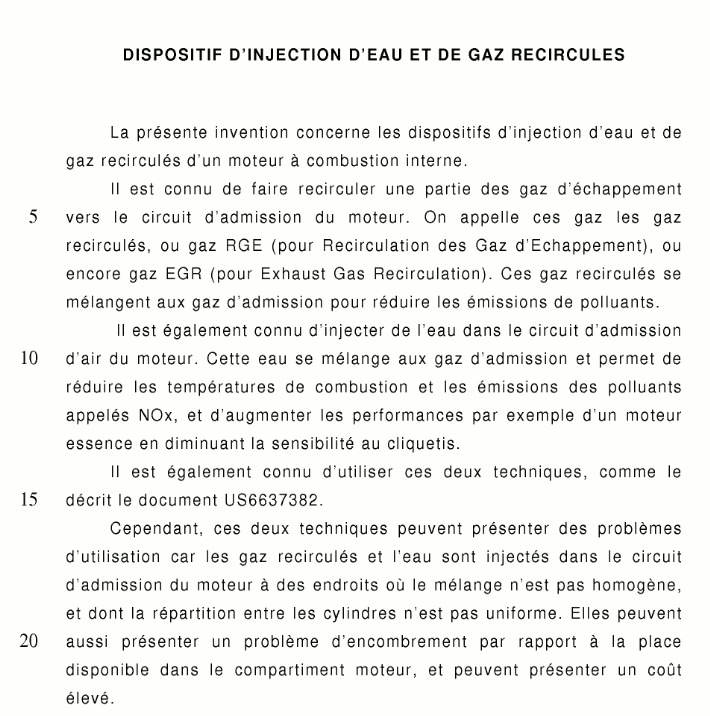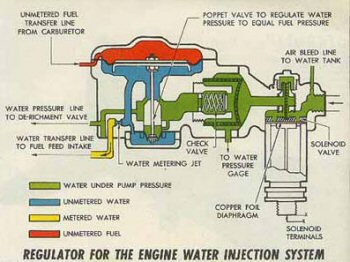I come to you because being a scientist by training, it has always interested me to see how a myth constantly invalidated experimentally AND theoretically by hundreds of people who do not know each other around the world, funded by completely different organizations could still hold firm .
(I know, I pass for an asshole, but my state of mind is direct and clear, you will not wonder 300 years what I think ...
Patent extract (introduction):

Download the full patent here: https://www.econologie.com/brevet-renaul ... -3435.html
The question I ask myself is "But where are these famous engines? We are in 2011 ".
Renault filed this patent on a water reinjection system in 2005 (someone also posted a post on it on this site). But did he really read the contents of the patent? The water already injected is cold (unlike Pantone, it already makes a difference): injecting preheated water is monstrous thermodynamic bullshit ... I invite you to snoop around the Carnot cycle to confirm that it increases the temperature of the cold source lowers the efficiency of the engine. If you then say that Carnot says anything, prove it (for my part I have a few hundred publications showing that at first glance, it's generally not too bad).
In addition (let's stay with this patent), the alleged advantages are not a reduction in consumption, but a reduction in NOx production per gram of fuel burned due to the reduction in engine temperature. In addition, the addition of water allows finer knock control. These two last pieces of information are perfectly correct is confirmed by scientists as much experimentally as theoretically.
On the other hand, did it occur to you that there could be a reason why this patent remains, even today, 6 years after filing, 4 or 14 years before the patent falls irreparably in the public domain , unexploited by Renault in its passenger vehicles? The reasons are simple: net loss of yield, corrosion, reduction in service life, deactivation of catalytic converters, etc. If you look closely, the manufacturers did not abandon the injection of water by chance: water was added to the fuel for powerful engines whose temperature had to be regulated (planes, military vehicles, etc.) or the clicking of which should be better controlled (methanol engine). With the advent of new materials for the automobile and thanks to the addition of additives in the fuel, the addition of water became unnecessary and the manufacturers were able to abandon it with great relief (our military vehicles are more 6 months now and our planes do more than 10 flights (imagine!).
What I have to recognize all the same, is that there is no doubt, if the Pantone system or equivalent is not mounted with the feet and is properly adjusted, that the fuel consumption per km will drop . But this comes at a price: the life of the engine, its performance and its power.
So yes, you will consume less per km (and therefore pollute less and again ... that is discussed), on the other hand, you would gain on ALL PLANS to buy a vehicle with a 1,2L engine rather than buying a 2,5L engine ... It's an initial choice, but if consumption matters, that's what should guide it.
(Well yes, the typical problem of "I bought a 4x4 but that's 17L / 100km! Help!")
In short, beyond the esoteric explanations on the alleged functioning of the Pantone system and equivalent (which we can come back to if necessary), at some point, we would have to ask ourselves the question of whether it would be better to buy a recent car rather than strive to operate one that is 20 years old without really knowing the result of the modification ( for what I read, if it is badly regulated (still it is necessary to have the material for), all the advantages disappear.)
In short, we must stop imagining that such a system is greener or offers better returns than a conventional engine: manufacturers have always done what they can to avoid it and the abandonment of the patent-related project that I cited is proof. Besides, go see what it is all over the world: almost all manufacturers have patented a system using water injection and except in certain niche markets, such engines no longer exist and it's not for nothing.




